Asylum
Updated 3 March 2016
Valid: 25 February 2016 to 25 May 2016
All data below relate to the year 2015 and all comparisons are with the year 2014, unless indicated otherwise.
Back to ‘Immigration statistics October to December 2015’ content page.
This is not the latest release. View latest release.
1.Key facts
Asylum applications from main applicants increased by 29% to 32,414 in 2015, the highest number of applications since 2004 (33,960). The largest number of applications for asylum came from nationals of Eritrea (3,729), followed by Iran (3,248), Sudan (2,918) and Syria (2,609). Including dependants, the number of asylum applications increased by 20% from 32,344 in 2014 to 38,878 in 2015, and there were around 1 dependant for every 5 main applicants.
Grant rates vary between nationalities; for example, at initial decision, the grant rate for Syrian nationals was 85%, compared with 21% for Pakistani nationals. The overall grant rate at initial decision for all nationalities was 39% in 2015.
Most applications for asylum are made by people already in the country (91% of applications in 2015) rather than on arrival in the UK at a port. Applicants tend to be young and male.
In 2015, the number of initial decisions on asylum applications increased by 46% to 28,950. Of these decisions, 39% (11,419) were grants of asylum or an alternative form of protection, compared with 41% (8,150) in the previous year. A separate Home Office analysis shows that for the period 2011-13, 32% of decisions were granted initially, with this proportion rising to 45% after appeal.
In addition, a total of 1,864 people were resettled in the UK in 2015. Of these, 1,194 (1,337 since the scheme began, 1,085 arriving in the last quarter of 2015) were granted humanitarian protection under the Syrian Vulnerable Persons Resettlement Scheme. On 7 September 2015, the Prime Minister announced an expansion to the existing Syrian Vulnerable Persons Resettlement Scheme. Through this expansion, it is proposed that 20,000 Syrians in need of protection will be resettled in the UK by 2020.
Estimated figures show the UK had the ninth highest number (39,000) of asylum applications within the EU in 2015, including dependants. Germany (431,000), Sweden (163,000) and Hungary (163,000) were the 3 EU countries that received the highest number of asylum applications, together accounting for 62% of asylum application in the EU.
2.Asylum applications and initial decisions for main applicants
| Year | Total applications | Total Initial decisions | Granted (1) | Granted as a % of initial decisions | Refused | Refused as a % of initial decisions | |
| 2011 | 19,865 | 17,380 | 5,649 | 33% | 11,731 | 67% | |
| 2012 | 21,843 | 16,774 | 6,059 | 36% | 10,715 | 64% | |
| 2013 | 23,584 | 17,543 | 6,542 | 37% | 11,001 | 63% | |
| 2014 | 25,033 | 19,782 | 8,150 | 41% | 11,632 | 59% | |
| 2015 | 32,414 | 28,950 | 11,419 | 39% | 17,531 | 61% | |
| Change: latest year | +7,381 | +9,168 | +3,269 | - | +5,899 | - | |
| Percentage change | +29% | +46% | +40% | - | +51% | - |
Table notes
Source: Home Office, Immigration Statistics October to December 2015,
Asylum table as 01q.
(1) Granted includes grants of asylum, humanitarian protection, discretionary leave, leave to remain under family life or private life rules, leave outside the rules and UASC leave.
3.Long-term trends in asylum applications for main applicants
The chart below shows the annual number of asylum applications made since 2001.
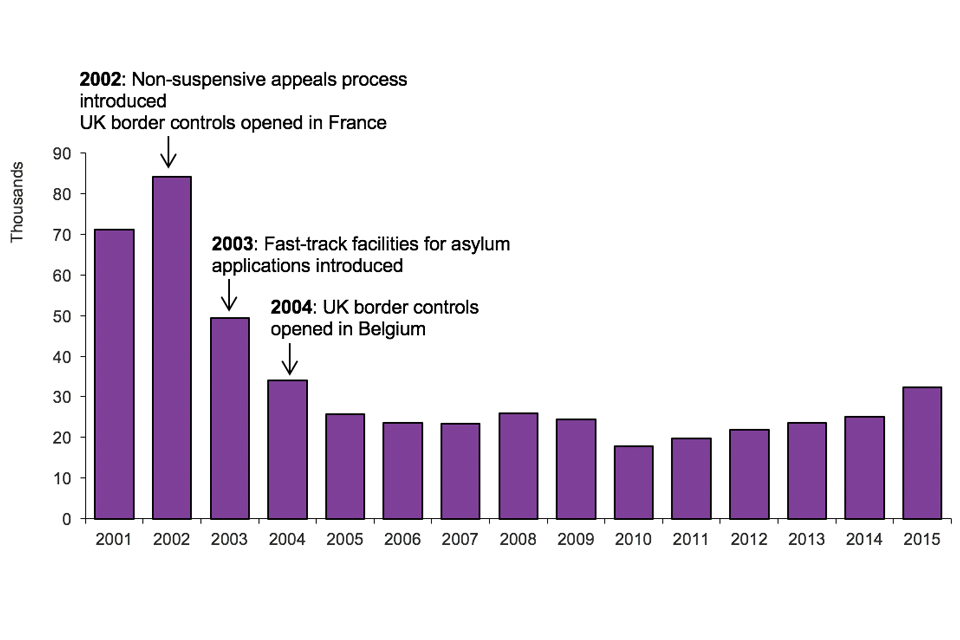
4.Nationalities applying for asylum
In 2015, the largest number of applications for asylum in the UK came from nationals of Eritrea (3,729), followed by Iran (3,248), Sudan (2,918) and Syria (2,609). In the same period, asylum applications from Sudanese nationals more than doubled to 2,918, from 1,449 in 2014.
World events have an effect on who applies for asylum at any particular time. For example, the number of applicants from Syria increased sharply following the outbreak of the Syrian civil war in early 2011. The 2,609 applications for asylum from Syrian nationals in 2015 compares with only 355 in 2011. In addition, increasing numbers of people have sought asylum from Eritrea, mirroring concern over human rights within that country. In 2015, there were 3,729 asylum applications from nationals of Eritrea compared to 797 in 2011.
The grant rate at initial decision for Eritrean nationals has fallen recently, coinciding with the publication of updated country information and guidance on illegal exit and national service in Eritrea in March 2015. In 2015, the proportion of initial decisions for Eritrean nationals that were grants of asylum or an alternative form of protection was 48%, compared with 87% in the previous year. This has been reflected in an increase in the number of appeals lodged by Eritrean nationals, from 172 in 2014 to 1,718 in 2015. Of appeals determined in 2015, 80% of those by Eritrean nationals were allowed, an increase from the 44% allowed in the previous year.
Grant rates for asylum, humanitarian protection, discretionary leave or other grants of stay vary considerably between nationalities. For example, 85% of the total decisions made for nationals of Syria were grants, compared with 21% for Pakistani nationals.
Top 5 nationalities applying for asylum, 2015 compared with 2014
| Ranking in 2015(2014) | Nationality | 2014 | 2015 | Grant rate in 2015 based on initial decisions (%) |
| 1 (1) | Eritrea | 3,233 | 3,729 | 48% |
| 2 (4) | Iran | 2,000 | 3,248 | 54% |
| 3 (6) | Sudan | 1,449 | 2,918 | 84% |
| 4 (3) | Syria | 2,025 | 2,609 | 85% |
| 5 (2) | Pakistan | 2,726 | 2,441 | 21% |
Table notes
Source: Home Office, Immigration Statistics October to December 2015, Asylum table as 01 q.
(1) Grant rates relate to the number of grants for asylum, humanitarian protection, discretionary leave or other grants of stay as a proportion of all initial decisions made in 2015.
5.Resettlement
In addition to those asylum seekers who apply in the UK, resettlement schemes are also offered to those who have been referred to the Home Office by UNHCR (the UN agency for refugees). In 2015, a total of 1,864 were resettled in the UK through this process. Of these, 1,194 were also granted humanitarian protection under the Syrian Vulnerable Persons Resettlement Scheme (VPRS). In 2015, 51% (605) of those resettled under the Syrian VPRS were under 18 years old, and half (593) were female. A total of 1,337 people have been granted humanitarian protection under the Syrian VPRS since the scheme began, including 1,085 who arrived in the last quarter of 2015.
On 7 September 2015, the Prime Minister announced an expansion to the existing Syrian VPRS. Through this expansion, it is proposed that 20,000 Syrians in need of protection will be resettled in the UK by 2020.
6.International comparisons
Figures in this section are based on data supplied by the individual countries to the Intergovernmental Consultations on Migration, Asylum and Refugees (IGC), UNHCR and Eurostat. Not all countries provide the latest data in time for each Immigration Statistics release. Where a figure is unavailable for a given month, we estimate it using the average of the last 3 months available, unless the time series is erratic, when we use the average of the last 12 months.
Including dependants, the total number of asylum applications to the European Union in 2015 was an estimated 1,225,000, more than double the number in 2014 (590,000).
Top EU countries receiving asylum applications, 2015
(Total number of applications 1,225,000 including dependants; some estimated data)
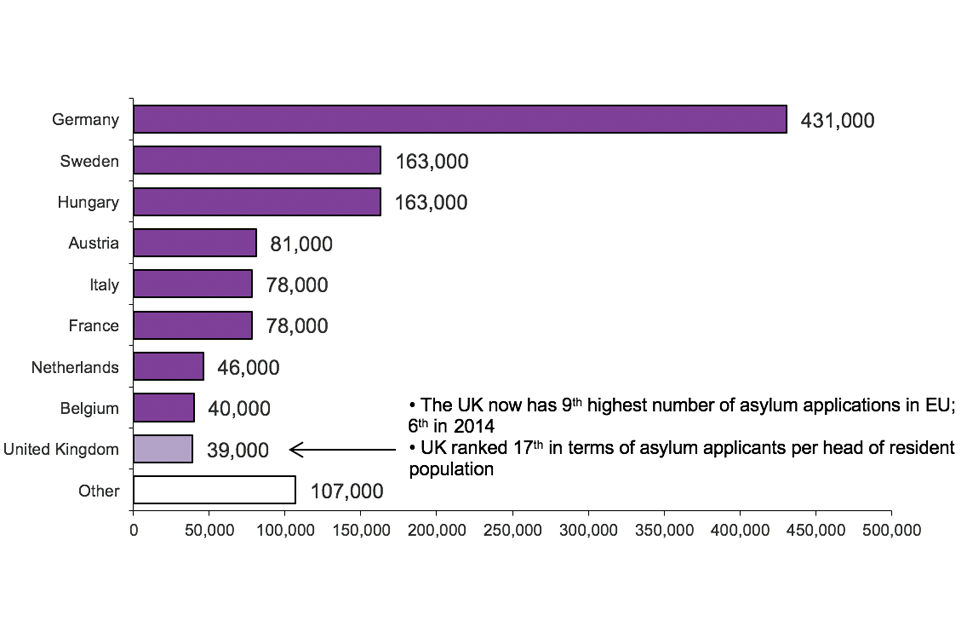
Chart notes
Source: Home Office, Immigration Statistics October to December 2015, Asylum table as 07 q.
(1) Figures are rounded to the nearest 1,000 and so may not sum to the total.
(2) The estimated figures in this chart are based on data supplied to IGC and UNHCR.
In the third quarter of 2015 (July to September), the latest provisional Eurostat data show that the nationalities with the highest number of people seeking asylum in the EU as a whole were Syrian, Afghan and Iraqis. The highest number of first-time asylum applications in July to September 2015 were registered in Germany (108,300 applications, or 26% of total applications in the EU), Sweden (42 500, or 10%) and Italy (28 400, or 7%). The UK received 11,900 first-time applications; 3% of the EU total. Germany received 36,000 applications from Syrians and 22,000 from Albanians, followed by Afghans (7,000) and Iraqis (6,000). These numbers exclude resettlement cases additionally accepted through the Syrian Vulnerable Persons Resettlement Scheme.
Between July and September 2015, the proportion of positive asylum decisions (for all nationalities) in Germany was 50% compared with 80% in Sweden and 37% in the UK .The average grant rate for a particular member state will reflect the nationalities of the people applying for asylum in that country and their respective likelihood of being accepted as refugees. In Germany, the people with the highest number granted refugee status between July and September 2015 were Syrians (18,000) and Iraqis (3,000). In contrast, only 15 Albanians were granted refugee status in Germany, while 15,095 were rejected.
When comparing figures for different EU Member States, it is important to bear in mind there are differences in the collection and reporting methodologies, as well as how asylum applications are processed, which may influence the comparability of the figures.
7.Outcome of asylum applications
The most recent data report on initial decisions made on asylum applications. However, some decisions will be challenged at the HM Courts and Tribunals Service (HMCTS), an executive agency of the Ministry of Justice, which considers appeals against the asylum decisions made by the Home Office.
The Home Office produces an analysis of applications for whole year cohorts of asylum seekers, in order to present the overall success rates following appeal. For most years, this will provide the most complete description of the outcome for asylum seekers; however, for the most recent years some cases will still be outstanding, as they have had less time to be processed. The analysis therefore only provides a “snapshot” of the recorded outcomes of the group (or cohort) of asylum applicants in any one year, at a particular time. This dataset is updated, in full, annually and is currently available up to 2014.
7.1Outcome of applications made between 2011 and 2013
The following chart gives an illustration of outcomes in the asylum system in the UK, for applications made in the years 2011 to 2013 (inclusive), where the outcome is known.
Indicative flows through the UK asylum system, where outcomes known, 2011–2013 data
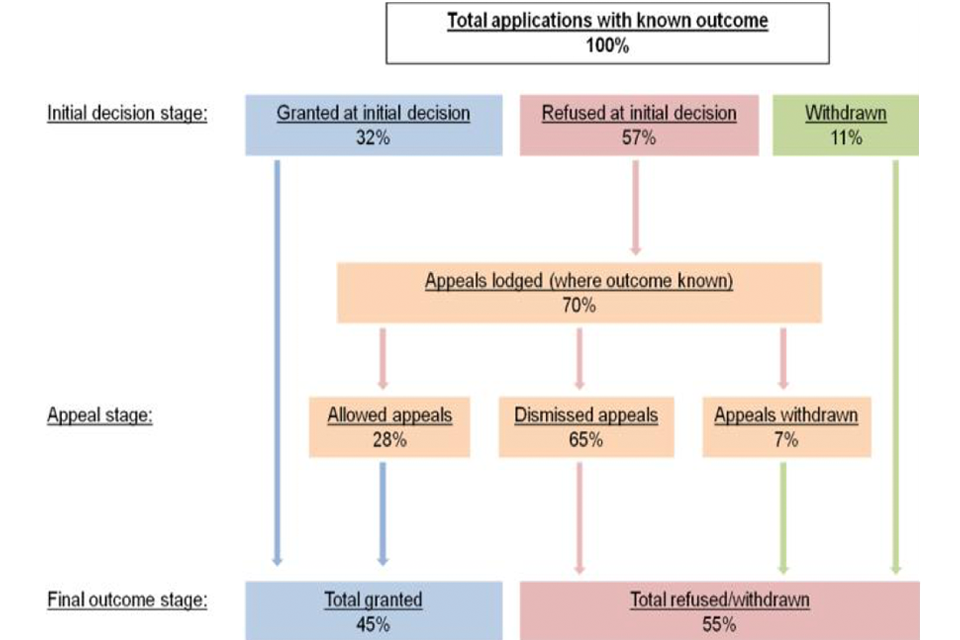
Chart notes
(1) Assumes all appeals lodged are as a result of a refused application. Latest data for 2011–2013 show 70% of all refusals resulted in an appeal being lodged.
(2) Figures are derived by combining data from the 2011, 2012 and 2013 cohort data from Table as 06.
(3) Cases where initial decision or appeal outcomes are unknown are not included in this analysis.
(4) Grant rates shown here relate to the outcomes of total applications made in each cohort year, and take withdrawn applications into account. They are therefore not directly comparable with the annual grant rates shown in the earlier table “Asylum applications and initial decisions for main applicants”, which gives grants as a percentage of total initial decisions made each year.
7.2Currently recorded outcomes for 2014 applications
Of the 25,033 main applicants who applied for asylum in 2014, 20,585 initial decisions had been made as at August 2015 when the statistics were compiled, including 9,230 grants and 11,355 refusals. A total of 8,436 appeals were lodged against decisions made on applications from 2014. Of these, 42% (3,553) were dismissed, 19% (1,635) were granted asylum or another form of protection and 38% were either withdrawn or the outcome was unknown at the time the statistics were compiled.
The outcomes for the 2014 cohort, as with previous years, will be updated in subsequent annual reports. However, of the 25,033 applications made in 2014, as at August 2015 when these statistics were compiled, it is estimated that 10,865 (43%) had been granted asylum, humanitarian protection or discretionary leave either at initial decision or after appeal; 8,634 (34%) cases had been refused; and around a fifth (22%; 5,534) were awaiting confirmation of an initial decision.
Outcome of asylum applications, by year of application
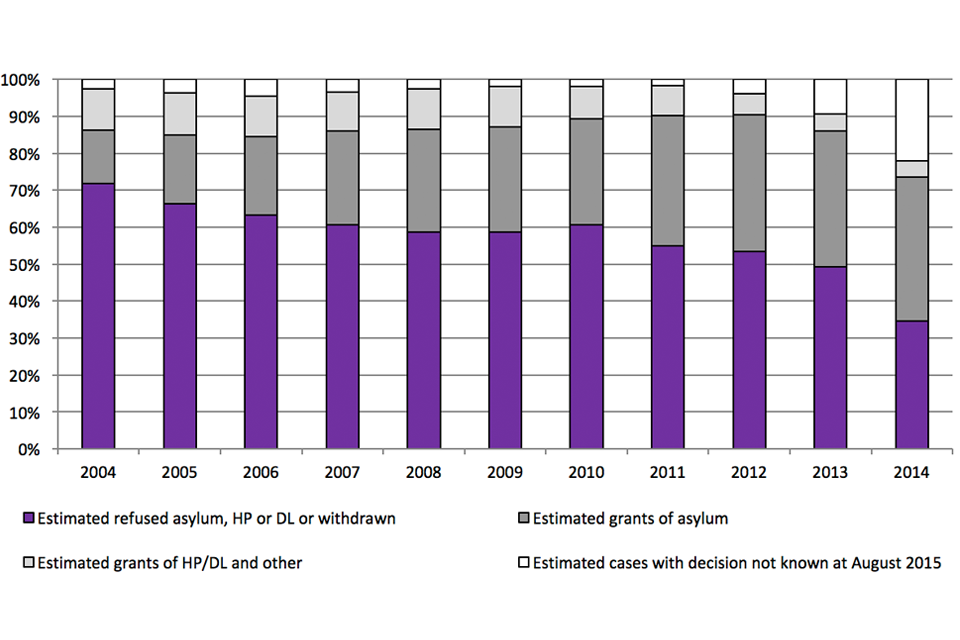
Chart notes
Source: Home Office, Immigration Statistics October to December 2015, Asylum table as 06.
(1) Chart shows the proportion of recorded outcomes of applications made in 2014, as at August 2015.
(2) Due to the large variety of routes that an asylum application can take to a final outcome, the analysis of the outcomes of asylum applications in any one year requires interpretation for a small percentage of cases. The proportions and underlying figures for final outcomes of the analysis of applications for the group (or cohort) of applicants in any one year, are therefore estimated.
(3) The proportion of applications awaiting the outcome of an initial decision or an appeal will inherently be lower in earlier years as there has been longer for the case to be processed than those from more recent years.
The overall proportion of applications granted asylum or a form of temporary protection either at initial decision or after having an appeal allowed, was estimated to be 26% in 2004; this proportion has steadily increased to 43% of applications made in 2014 (where the outcome is known), as shown in the above chart.
In addition, the outcome analysis also shows how the final grant rates vary by country of nationality. For example, in 2014, 78% of Eritrean nationals applying in 2014 were granted asylum or another form of protection following initial decision and after appeal, compared with 25% of Pakistani applicants.
The recorded outcomes of asylum applications made in 2015 are due to be published in August 2016.
8.Support provided to asylum seekers
At the end of 2015, 34,363 asylum seekers and their dependants were being supported in the UK under Section 95 (either in supported accommodation or receiving subsistence only support), compared with 29,753 at the end of 2014. Although this number has risen since 2012, the figure remains considerably below that for the end of 2003 (the start of the published data series), when there were 80,123 asylum seekers in receipt of Section 95 support.
Asylum seekers in receipt of Section 95 support, by local authority, per million population, as at end of 2015
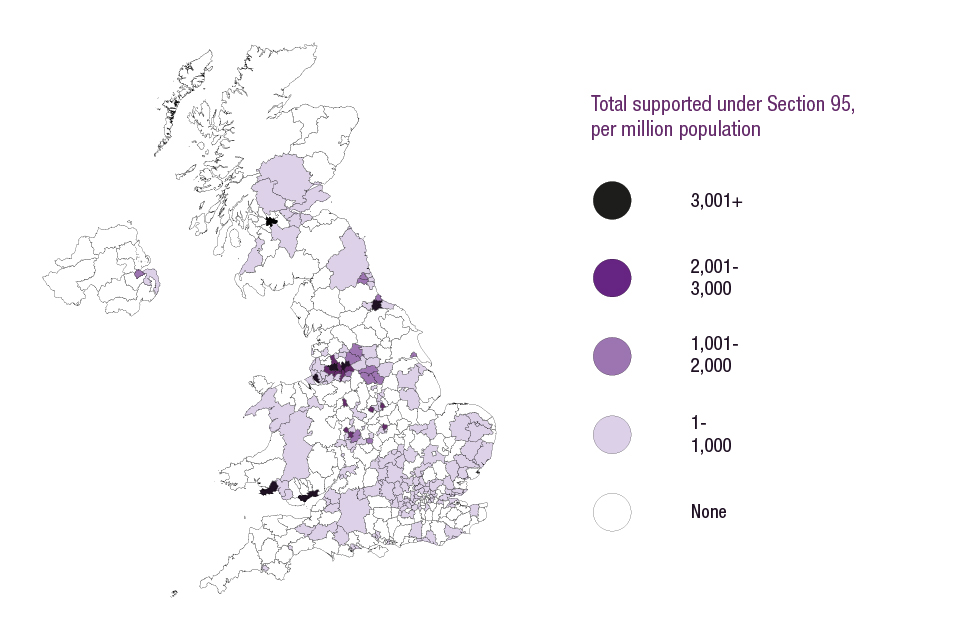
Chart notes
Source: Home Office, Immigration Statistics October to December 2015, Asylum table as 16 q; Population figures sourced from the ONS 2014 Mid-year population estimates, published 25 June 2015 .
The number of asylum seekers in receipt of Section 95 support by local authority, as at the end of each quarter, is available in Asylum table as_16_q (volume 4 of the Asylum data tables).
There were 3,821 failed asylum seekers and their dependants receiving support (under Section 4) at the end of 2015. Failed asylum seekers (main applicants only) receiving support under Section 4 peaked at the end of September 2009 (12,019).
9.Applications pending
At the end of 2015, 26,409 of applications received since April 2006 from main applicants were pending a decision (initial decision, appeal or further review), 15% more than at the end of 2014 (22,974). The number pending an initial decision for less than or equal to 6 months increased by 68% (from 8,640 to 14,485) but was largely balanced by the 57% decrease of initial decisions which had been pending for more than 6 months, which fell to 3,626 from 8,427 in 2014.
Since January 2014, the Home Office has reallocated resources to this area of work and this is reflected in the 46% (9,168) rise in the number of initial decisions on asylum applications for 2015.
10.Asylum appeals
The HM Courts and Tribunals Service received 14,041 asylum appeals from main applicants in 2015, a 70% rise compared with 2014 (8,241) reflecting the higher number of decisions in this period.
Appeal determinations have increased from 6,178 in 2014 to 9,115 in 2015. This remains below the peaks in the number of appeals in 2009 (14,340) and the number of determinations in 2010 (14,723). In 2015, the proportion of determined appeals that were dismissed was 59%, while 35% of appeals were allowed and 5% were withdrawn.
11.Unaccompanied Asylum-Seeking Children (UASC)
An Unaccompanied Asylum-Seeking Child (UASC) is a person under 18, or who, in the absence of documentary evidence establishing age, appears to be under that age, is applying for asylum on his or her own right and has no relative or guardian in the United Kingdom.
There were 3,043 asylum applications from UASC in 2015, an increase of 56% from 1,945 in 2014. Overall, UASC applications represented 9% of all main applications for asylum. Despite the recent increase in UASC applications, they remain below the peak of 3,976 in 2008. The countries with the highest number of UASC applications in the UK were Eritrea (694), followed by Afghanistan (656) and Albania (456). These three countries contributed to more than half (59%) of total applications.
There were 1,932 initial decisions for UASC in 2015, 52% higher than in 2014 (1,269). Of these, 66% were grants, compared to 71% in the previous year.
12.Age disputes
Some asylum applicants claim to be children but there may be doubts as to whether this is in fact the case. In 2015, 766 asylum applicants had their age disputed and there were 700 recorded as having an age assessment. Of those who completed age assessments in 2015, 68% had a date of birth showing that they were over 18, despite claiming to be a child when the age dispute was raised.
13.Dependants
Including dependants, the number of asylum applications increased by 20% from 32,344 in 2014 to 38,878 in 2015, an average of 1 dependant for every 5 main applicants. In the same period, 9,264 initial decisions were made relating to dependants. Of these 2,483 (27%) were granted asylum, or a form of temporary protection or other type of grant, and 6,781 (73%) were refused.
14.Data tables
Data referred to here can be found in the following tables:
Asylum vol. 1: Tables as 01 to as 02.
The following tables are included in this volume:
as 01 Asylum applications and initial decisions for main applicants, by country of nationality
as 01 q Asylum applications and initial decisions for main applicants, by country of nationality
as 02 Asylum applications and initial decisions for main applicants and dependants, by country of nationality
Asylum vol. 2: Tables as 02 q to as 06
The following tables are included in this volume:
as 02 q Asylum applications and initial decisions for main applicants and dependants, by country of nationality
as 03 Asylum applications from main applicants, by age, sex and country of nationality
as 04 Asylum applications from main applicants and dependants, by age, sex and country of nationality
as 05 Asylum initial decisions from main applicants, by sex and country of nationality
as 06 Outcome analysis of asylum applications, as at August 2015
Asylum vol. 3: Tables as 07 to as 13 q
The following tables are included in this volume:
as 07 Asylum applications received in Europe and elsewhere for main applicants and dependants
as 07 q Asylum applications received in Europe and elsewhere for main applicants and dependants
as 08 Asylum applications received from Unaccompanied Asylum-Seeking Children, excluding dependants, by sex and age at time of application
as 08 q Asylum applications received from Unaccompanied Asylum-Seeking Children, excluding dependants, by sex and age at time of application
as 09 Initial decisions on asylum applications from Unaccompanied Asylum-Seeking Children, excluding dependants, by sex and age at initial decision
as 09 q Initial decisions on asylum applications from Unaccompanied Asylum-Seeking Children, excluding dependants, by sex and age at initial decision
as 10 Age disputes raised and resolved for asylum applicants, by country of nationality
as 10 q Age disputes raised and resolved for asylum applicants, by country of nationality
as 11 Asylum main applicants accepted onto the fast-track process, by country of nationality
as 12 Outcomes of asylum main applicants accepted onto the fast-track process
as 13 q Main applicants refused asylum and eligible for the non-suspensive appeals process, by country of nationality
Asylum vol. 4: Tables as 14 to as 19 q
The following tables are included in this volume:
as 14 Asylum appeal applications and determinations, by country of nationality and sex
as 14 q Asylum appeal applications and determinations, by country of nationality
as 15 Applications for asylum support, by support type and nationality
as 16 q Asylum seekers in receipt of Section 95 support, by local authority, as at end of quarter
as 17 q Asylum seekers in receipt of Section 95 support, by country of nationality and UK region, as at end of quarter
as 18 q Asylum seekers in receipt of Section 4 or Section 98 support, and decisions to grant Section 4 support
as 19 q Refugees (and others) resettled, including dependants
15.Background Information
This section covers asylum applications, initial decisions, appeals, Unaccompanied Asylum-Seeking Children (UASC), age disputes, support, resettlement and international comparisons.
15.1Migration Transparency Data webpage
A range of key input and impact indicators are currently published by the Home Office on the Migration Transparency Data webpage.
